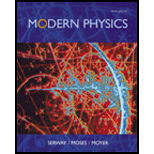
(a)
The drift speed of the electrons in GaAs.
(a)
Answer to Problem 12P
The drift speed of the electrons in GaAs is
Explanation of Solution
Write the equation for the drift speed.
Here,
Conclusion:
Substitute
Therefore, the drift speed of the electrons in GaAs is
(b)
The percent of the drift speed to the electron’s thermal speed at
(b)
Answer to Problem 12P
The percent of the drift speed to the electron’s thermal speed at
Explanation of Solution
Write the equation connecting the kinetic energy and the thermal energy of the electron.
Here,
Rewrite the above equation for
Write the equation for the percentage of the drift speed to the electron’s thermal speed.
Conclusion:
The value of
Substitute
Substitute
Therefore, the percent of the drift speed to the electron’s thermal speed at
(c)
The average time between electron collisions.
(c)
Answer to Problem 12P
The average time between electron collisions is
Explanation of Solution
Rewrite equation (I) for
Write the equation for the electron mobility.
Here,
Equate the above two equations and rewrite it for
Conclusion:
The value of
Substitute
Therefore, the average time between electron collisions is
(d)
The electronic mean path.
(d)
Answer to Problem 12P
The electronic mean path is
Explanation of Solution
Write the equation for the electronic mean path.
Here,
Conclusion:
Substitute
Therefore, the electronic mean path is
Want to see more full solutions like this?
Chapter 12 Solutions
Modern Physics
- The energy gaps Eg for the semiconductors silicon and germanium are, respectively, 1.12 and 0.67 eV. Which of the following statements, if any, are true? (a) Both substances have the same number density of charge carriers at room temperature. (b) At room temperature, germanium has a greater number density of charge carriers than silicon. (c) Both substances have a greater number density of conduction electrons than holes. (d) For each substance, the number density of electrons equals that of holes.arrow_forwardIs it feasible to describe the distinction between a conductor and an insulator using a semiconductor as an example? Why not use a graph to explain the arguments you're making?arrow_forwardAt what temperature do 1.30% of the conduction electrons in lithium (a metal) have energies greater than the Fermi energy EF, which is 4.70 eV?arrow_forward
- Consider a copper wire that is carrying, say, a few amperes of current. Is the drift speed vd of the conduction electrons that form that current about equal to, much greater than, or much less than the Fermi speed vF for copper (the speed associated with the Fermi energy for copper)?arrow_forwardGold has an atomic mass of 197 u, a density of 19.3 x 10^3 kg/m^3, a Fermi energy of 5.54 eV, and a resistivity of 2.04 x 10^-8 ohms. Estimate the mean free path in atom spacings between collisions of the free electrons in gold under the assumption that each gold atom contributes one electron to the electron gas.arrow_forwardCan a semiconductor be used to describe the distinction between a conductor and an insulator? Why not use a graph to support your arguments?arrow_forward
- What mass of phosphorus is needed to dope 1.0 g of silicon so that the number density of conduction electrons in the silicon is increased by a multiply factor of 106 from the 10^16 m-3 in pure silicon.arrow_forwardthe carrier distribution in the conduction band is:nc(E) = gc(E) . f(E) a) For a non-degenerate semiconductor, show that nc(E) has a maximum at E = Ec + ½ kT b) What is the ratio of carrier distribution at E = Ec + kT to that of the max value ?arrow_forwardIs it feasible to describe the distinction between a conductor and an insulator using a semiconductor as an example? Why not use a graph to explain your points?arrow_forward
- Why Intrinsic Semiconductor materials are the bad conductors of electricity? Elaborate the process to make them full conductors?arrow_forwardWhen a photon enters the depletion zone of a p-n junction, the photon can scatter from the valence electrons there, transferring part of its energy to each electron, which then jumps to the conduction band. Thus, the photon creates electron–hole pairs. For this reason, the junctions are often used as light detectors, especially in the x-ray and gamma-ray regions of the electromagnetic spectrum. Suppose a single 662 keV gamma-ray photon transfers its energy to electrons in multiple scattering events inside a semiconductor with an energy gap of 1.1 eV, until all the energy is transferred. Assuming that each electron jumps the gap from the top of the valence band to the bottom of the conduction band, find the number of electron – hole pairs created by the process.arrow_forwardWhat is the number density of conduction electrons in gold, which is a monovalent metal? Use the molar mass and density provided in Appendix Farrow_forward
 Modern PhysicsPhysicsISBN:9781111794378Author:Raymond A. Serway, Clement J. Moses, Curt A. MoyerPublisher:Cengage Learning
Modern PhysicsPhysicsISBN:9781111794378Author:Raymond A. Serway, Clement J. Moses, Curt A. MoyerPublisher:Cengage Learning
